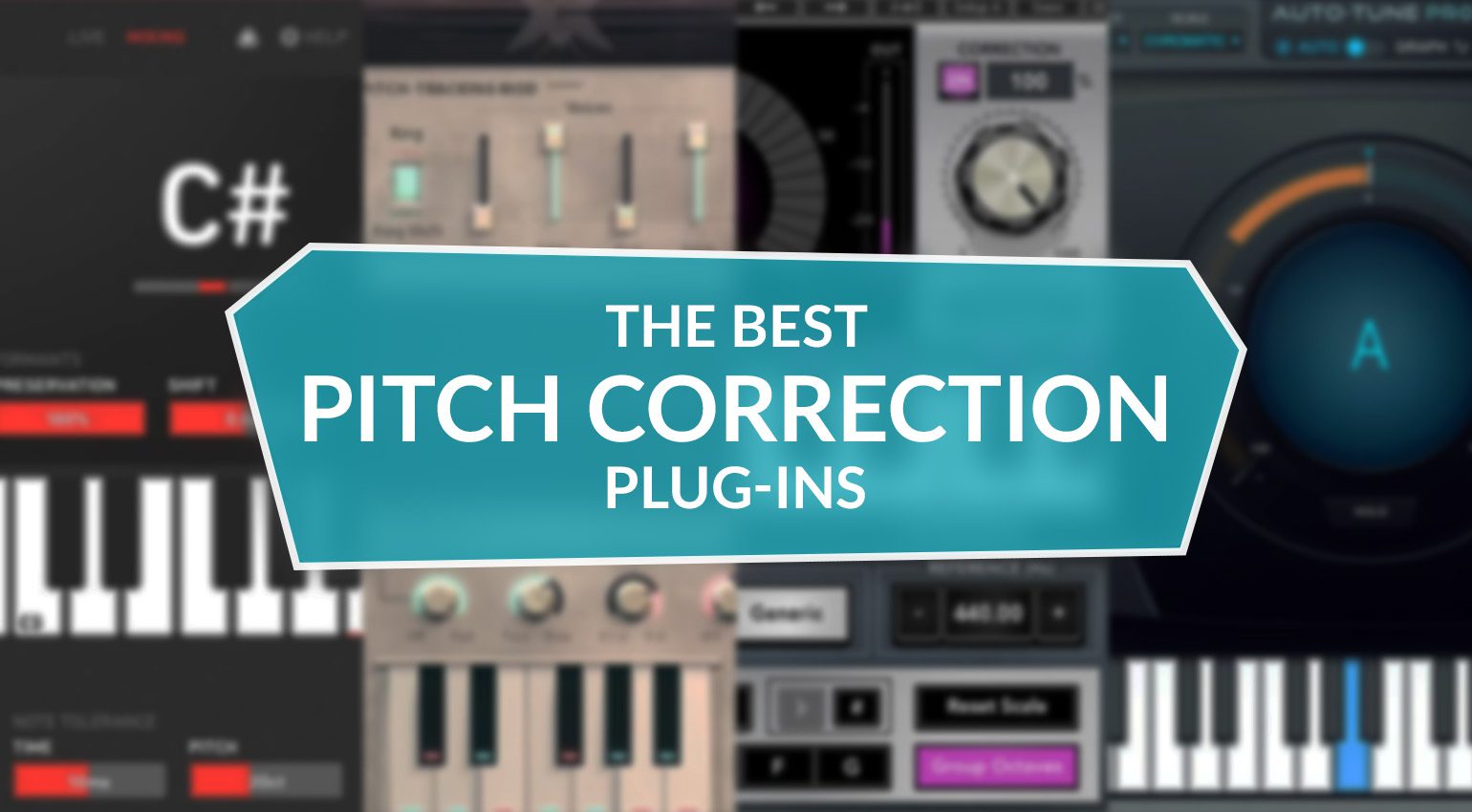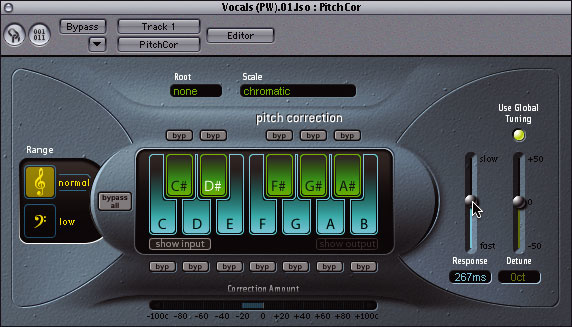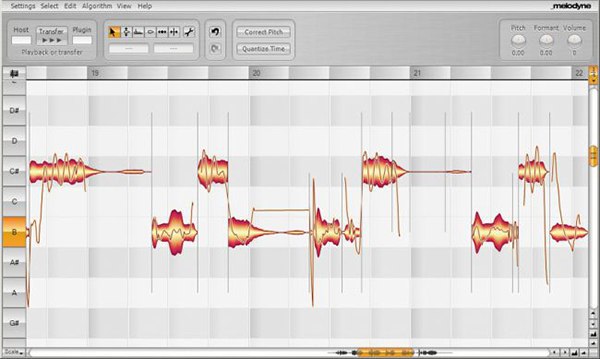- Logic Pitch Free
- Logic Pro Pitch Correction Plugin For Garageband
- Create Autotune Logic Pro
- Best Pitch Correction Software
- Logic Pro Pitch Correction Plugin Fl Studio
Logic 's Pitch Correction plug-in can be placed before or after a compressor and, intuitively, I feel it has a better chance of working properly if it comes afterwards, as it will receive a more constant level. Having said that, this plug-in is so good that it copes with all normal vocals, compressed or not. How to use the Flex Pitch function in Logic Pro X. How to use the Flex Pitch function in Logic Pro X.
My name is Julian Wharton, and I am a top-rated Logic Pro X instructor on AirGigs. When I’m not helping others, I am a professional producer who makes music for artists, podcasts and films from my East London studio.
This article aims to show you that while third party plugins are often amazing and undeniably necessary at a pro level, many of the functions people are paying for are actually available within Logic. Furthermore, it seeks to show you some tools you may not be aware you already owned!

We often take for granted the monumental shift in music production technology that has happened in the past twenty years. For just $199, Logic Pro X gives you an overwhelming bundle of technology which would have cost hundreds of thousands of dollars for previous generations. There are a range of DAWs, but it’s clear Logic offers easily the most accessible and in my opinion broad DAW, with pro level tools ranging from arrangement and sound design to mixing and mastering.
Despite the range of tools available in Logic, during my sessions one question keeps coming up – do I need to buy third party plugins? I understand why this is happening, the music production industry has fallen foul to some pretty ugly marketing in the last couple of years which essentially tries to neg you into buying things with headlines like ‘why your mix sucks’. It also likes to take the marketing approach of dieting products by saying things like ‘become the best producer in the world with no effort for just $5’ or ‘do you want to get 1,000,000 streams on your track in 3 weeks!?’.
Both of these are playing on the worst parts of creative personalities, self-doubt and visions of ‘success’. This is all meant as constructive, I’ve done exactly the same thing at different points in my career, but hopefully this has given you some pause for thought on how we act as consumers within the music production marketplace, which it’s easy to forget is a business.
I often encounter people who purchase third party plugins, for example a compressor, without actually understanding how a compressor works. Not only does this mean they won’t be able to get the most from the plugin, it also means that they’re unable to make a good comparison between products. This means that what they’ve bought into is the marketing and the feeling of quality, rather than the quality of the product itself. We’ve all been there, but it’s easy to confuse the feeling of accomplishment from buying a new plugin with progress.
Without further ado, here are 5 plugins which you should learn to make the most of in Logic Pro X before considering buying alternatives. There are many more, but these are the five I often end up discussing in my sessions.
Vintage EQ Collection
Since 2018’s update, Logic has included three vintage emulation EQs modelling the Neve 1073, API 560 and Pultec EQP-1A, each of which have their own idiosyncrasies. Logic’s channel EQ has a very digital workflow with endless possibilities, which also makes knowing what to do quite hard. As analog EQs are physical things, you can’t build endless possibilities into them, design choices need to be made and possibilities limited. This actually gives beginners a bit of an easier ride because there are fewer controls. There are a range of third party emulations of the same EQs available on the market, but you should learn how to use these first before considering buying anything else.
Logic’s Compressor
For me, compression is the number one most misunderstood part of mixing and production, but also an area where people seem intent on buying products they don’t need. A compressor is a little complex, but ultimately it’s about controlling your dynamics. Do you want your sound to be more punchy, or have more loudness through enhanced detail? Compressors can shape your tone like this, make your track sound larger than life and much more – but only if you understand how to use them. The vast majority of compressors work in a very similar way and Logic’s compression plugin includes emulations of seven types of hardware with great results. It’s a great compressor that I still use all the time and whilst there are benefits of third party plugins, you’re better off learning how to use compression first.
Flex Pitch & Pitch Correction
We all want to have great vocals, but many of the vocal recordings you hear have been pitch corrected using software like Melodyne and Antares. This takes nothing away from the vocalist, it just improved the performance and makes it even tighter. These softwares can be expensive but luckily Logic has Flex Pitch for individual note / timing correction, as well as the Pitch Correction plugin, which confusingly, is a pretty good auto-tune.
Alchemy
Lastly, if you’re looking for new sounds, or to learn more about sound design and synthesis, Alchemy is a brilliant tool included in Logic Pro X and it used to be a third party plugin. Not limited to synths, it also has a number of soundtrack fx and soundscapes as well as granular, additive and sampling options.
Chromaverb
Logic’s reverbs were a little clumsy until they added Chromaverb a couple of years ago. It has an updated interface which is pretty intuitive, but crucially it also allows you to sync your decay and pre-delay times to the tempo (no more guessing!), which is a feature even some more advanced reverbs don’t have. Sounds great too!
All in all, the message here is that Logic is an amazing piece of software and it’s incredibly cheap, lowering the entry point to music production like never before. Each update adds more functionality so take some time to understand the tools Logic includes before you buy third party plugins. Rather, spend that money to buy either knowledge or time, both of which will go a lot further towards you achieving your goal of making and releasing music.

Tutorial – Using Auto-Tune Pro in Logic Pro X – Production Expert Antares has recently come out with a fantastic upgrade to their flagship pitch correction plug-in, Auto-Tune. The new Auto-Tune Pro has a completely redesigned interface, making it easier and more intuitive to use than ever. COMPARISON AT 3:37A first look at AutoTune Pro from Antares. After using Logic Pro X's stock Pitch Correction for years, i've decided to upgrade to AutoTune.
Over the last decade, autotune has evolved from a subtlety producers and engineers use to alter vocals and correct out of tune notes to a full-blown identity for certain musicians. Now, predominantly used in the realms of trap and left-field pop music, fans will even be able to identify an artist just by the way their distinct autotune sounds. There are a variety of plugins available which can generate these desired sounds, so to help you get to grips with what autotune does and the best tools for the job, we’ve put together a list of the best autotune plugins on the market.
If you’re looking to learn how to produce music like a pro working with audio plugins and DAWs, our online school can help. Studying online with Point Blank has never been better and now, we’re currently offering 25% off our selected London, online and LA courses using the codes: LONDON25, ONLINE25 and LA25.

What is Autotune?
MeldaProduction, a renowned audio plugin company used and promoted. How to Use Autotune in Logic Pro XMore Free Logic Pro Videos - Correction effect overview for how to do autotune on logic pro x. Tutorial – Using Auto-Tune Pro in Logic Pro X – Production Expert. Antares has recently come out with a fantastic upgrade to their flagship pitch correction plug-in, Auto-Tune. The new Auto-Tune Pro has a completely redesigned interface, making it easier and more intuitive to use than ever. Logic X’s Flex Pitch is a fantastic asset to us all, and it’s free of course.
Autotune essentially is a piece of digital software which can alter the pitch of a singer’s voice during a live performance or afterwards in post-production. The way autotune works is by changing the speed of the vibration of a certain note to increase or decrease the pitch. To create a seamless and smooth sound, autotune can then remove or add vibrations to keep the duration of the note the required length. Although this highly sought after robotic effect can be created by a vocoder and talkbox it’s important not to get them confused. The vocoder, which was invented in 1938, synthesizes human speech using different band frequencies whereas a talkbox lets musicians shape the sound of an instrument using their mouth and a plastic tube.
1. Antares Audio Technologies Auto-Tune
As the original developers and registered trademark owners of the autotune effect, it only seems right to head up our list with Antares Audio Technologies Auto-Tune. Since its initial release in 1997 Antares Auto-Tune plugins have come a long way. They now have a number of different versions available such as their flagship Auto-Tune Pro ($399) which is the most complete and advanced edition of Auto-Tune to their affordable Auto-Key ($49) and everything in between. Antares Auto-Tune is great for both detailed transparent tuning and creating that extreme autotune effect using a MIDI keyboard. Check out their different audio devices here.
2. Waves OVox
Our partners, Waves Audio, are renowned for the quality of their audio plugins – and their autotune plugin is no different. OVox is an all in one powerhouse which enables you to pitch, tune, harmonize and arpeggiate vocals as well as create classic vocoder & talkbox effects. The Note Mapper allows you to easily work with chords, scales and harmonies adding Daft Punk-style robotic tones to your vocals.
3. Melodyne
Although Antares were the first to create the autotune effect, Celemony developed their own stand-out take on the effect with Melodyne. Melodyne enables music producers and sound engineers to edit audio in crystal clear ways by editing notes directly. The ability to manipulate the pitch, formants, dynamics and timing of the on-screen notes allows you to reimagine and edit vocals, piano, guitar, synth and more hours, weeks or even years after the recording session. Although not the best for extreme autotune effects the 99€ essential version is great for detailed transparent tuning.
4. The Mouth
From Tim Exile, the man who brought us ‘The Finger‘, The Mouth helps generate melodies and harmonies out of any audio you feed into it. Whether you’re a singer, beatboxer, bass guitarist or synth player, you’ll be able to channel your sounds into The Mouth. The plugin is able to detect the pitch of an incoming audio source, autotune it and transform it into a scale or customised melody from MIDI notes.
5. Logic Pro’s Flex Pitch
Logic Pro’s inbuilt Flex Pitch is a stock plugin which can yield fantastic results. When activated, Flex Pitch splits your vocal or audio sample up into separate pitches so it’s easy to see which notes are being triggered by the sound. Once editing your audio samples you’ll be able to automate the volume, adjust vibrato, the formant and more giving you complete control of how your sound will end up. Take it to the extreme or keep your edits subtle with Logic’s Flex Pitch.
6. BeatLab’s Autotune for Ableton Live
Logic Pro X Auto Tune Plugin 2020

Our friends over at BeatLab have modded Cycling 74 Autotuna which is included in Max 7 Pitch and Time Machine pack. Now, with BeatLab’s moded autotune, you can easily select which scale you want to pitch correctly. It’s incredibly simple and easy to use – see for yourself by watching the video here.
The above list is by no means exhaustive and represents just a small amount of the very best of the wealth of autotune plugins available to producers today. Though the above plugins are, in our opinion, our favourite and most-used in our own productions, it’s always best to experiment with others to find out what works for you.
If you’re interested in learning more about how VSTs work, as well as the likes of Ableton, Logic Pro and more, you can register to study with us at Point Blank online.
Register to Access Free Courses, Plugins, Projects, Samples & More
Logic Pro X Auto Tune Plugin Ugin Fl Studio
Logic Pitch Free
Logic Pro X Auto-tune Plug-ins
When you register with Point Blank, you access an array of free sounds, plugins, online course samples, access to our social network Plugged In and much more! Simply register below and visit our Free Stuff page to get your hands on a range of exclusive music-making tools and tutorials provided by the team. Fill your boots!
This post is included in News, Round-ups
Whether you’re a music producer, podcast editor, or filmmaker, learning how to automate effects in your DAW can add a unique and creative touch to your work. For example, automating a saturation plugin that gets harsher over time can bump up your horror movie’s creepiness factor. Similarly, automating a rising low cut filter on an EQ plugin can produce a feeling of drifting away. In this tutorial, you’ll learn how to automate effects in Logic Pro X.
Logic Pro X Auto Tune Plugin Download
For the purposes of this tutorial, we’ll be automating the low cut filter in Logic Pro X’s Channel EQ plugin. As you can see in the screenshot below, there is an instance of Channel EQ to the track named “Track” – sorry about that. 😅
The first step is to enable the Automation Toggle in Logic Pro X’s menu bar. After clicking the Automation Toggle, the background of your tracks will become more opaque, and you’ll also see a horizontal automation line appear in the middle of each track. In each track’s info section, you’ll see additional dropdown like “Read” and “Volume” as well.

Click on the dropdown that says “Volume”, and you’ll notice it’s a menu that lets you select a parameter to automate. In addition to volume and global effects under “Main”, you’ll also see submenus for the selected track’s effects plugins as well. As stated earlier, we’ll be automating Channel EQ’s low cut filter, so let’s click on “Low Cut Frequency” in the “1 Channel EQ” submenu.
Logic Pro X Autotune Plugin Download
After the “Low Cut Frequency” parameter is selected, simply click on the automation line to create an automation point. You can drag the point up and down to set parameter value. In this case, dragging the point up will increase the low cut frequency, and dragging it down will do the opposite. In the screenshot below, there’s an automation point at 50 Hz at the start of the timeline.
Now let’s create a second automation point seven bars in at 1,100 Hz. As you can see, the change in low cut frequency is reflected in the Channel EQ plugin. At this point, if you start playback from the beginning of the timeline, you’ll see the low cut filter move in realtime in the Channel EQ plugin.
Logic Pro Pitch Correction Plugin For Garageband
Free Autotune Plugin Vst
Create Autotune Logic Pro
If you hate linear automation, you’re in luck because curve automation is easy in Logic Pro X. In some situations, using a curve to automate effects may yield a more “natural-sounding” result – whatever that means. To use curve automation, hold down Ctrl+Shift and click on an existing automation line. You can drag it up and down to change the type and intensity of the curve.
Effects automation is a very useful tool for a variety of use cases including modern pop production and sound design for film. Whether you’re creating an annoying pan effect for the next Top 40 hit or leveling out dialogue levels in a hipster indie film, you can get it done in Logic Pro X.
Best Pitch Correction Software
If you have any questions about how to automate effects in Logic Pro X, feel free to reach out to me on Twitter or send me an email.